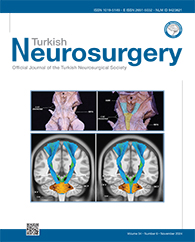2Afyonkarahisar Public Hospital, Department of Radiology, Afyonkarahisar, Türkiye
3Artuklu University, Department of Radiology, Mardin, Türkiye DOI : 10.5137/1019-5149.JTN.45315-23.2 AIM: To investigate the surgical outcomes in patients with nonfunctional pituitary adenomas (NFPAs) exhibiting visual field defects (VFDs) in order to ascertain the impact of the volume of adenoma excised during surgery on recurrence rates and improvements in VFDs.
MATERIAL and METHODS: From a cohort of 150 individuals diagnosed with NFPAs and exhibiting suprasellar extensions accompanied by VFDs, we selected 114 patients who fulfilled the inclusion criteria for further analysis after a comprehensive retrospective review. All selected patients underwent pituitary magnetic resonance imaging (MRI) examinations, and volumetric measurements were conducted on T1 contrast sequences using the Syngo.via software. Measurements were derived from MRI scans taken 24 h preoperatively, 24 h postoperatively, at 3 months, and at the end of the first year postsurgery. Volumetric values were compared between patients who underwent subsequent surgeries due to recurrence and those who did not. Similarly, the variables were evaluated in patients experiencing an improvement in VFD, those whose VFD remained stable, and those experiencing a deterioration in VFD.
RESULTS: The recurrence rate was 19.3%. Among patients who underwent a second surgery due to recurrence, the presurgical adenoma volume, the adenoma volume removed based on the 24-h postoperative MRI, and the volumes recorded in the 3-month and 1-year postoperative imaging were significantly greater than those in patients who did not require a second surgery. Remarkable improvements were identified in 84.2% of patients with VFD complaints and 62.5% of those with visual acuity complaints.
CONCLUSION: Adenoma volume measurements exerted a significant impact on recovery from VFDs and the need for a second surgery. Although the choice of surgical methodology does not definitively affect outcomes, an in-depth evaluation of variations in adenoma volume can provide valuable prognostic insights.
Keywords : Retrospective Studies, Pituitary Adenomas, Visual Field Defects, Prognosis, Recurrence




